
articles
Through the ages the harp has attracted a great deal of attention in artwork and literature, and the Gaelic crot/cláirseach is no exception. Yet it is difficult to disentangle and sort the many layers of history and mythology embedded in tradition, and the boundaries between them are vague and fluid. Intrigued years ago by mentions of precious metal strings in the old literature (see the appendix), I began to broach the subject to experts in various fields, only to meet with almost universal scepticism and even occasional ridicule. Undaunted, I engaged Jay Witcher to investigate the practicality of gold strings, and his communications with a metallurgist were encouraging. Yet the lack of interest shown by historical metallurgists made it difficult to proceed, and it wasn’t until 1999 that a successful stringing experiment with silver wire from Australia gave us the courage to try gold. The occasion was the stringing of a Trinity College replica made by David Kortier—completed just six days prior to its debut concert! The continued success of my Trinity's gold strings is well proven and today numerous harpers utilise precious metal strings on their instruments.
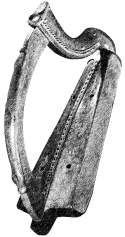
1.Trinity College harp, c.14thC.
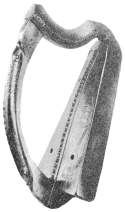
2. Queen Mary harp, c. 15th C.
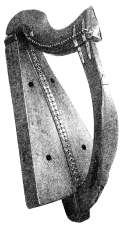
3. Lamont harp, c. 15th C.
The following discussion, based on one first published in the Historical Harp Journal (vol. 13 #3, Summer 2003), will serve as a guide along the tricky path from myth to reality...
Strings of Gold
Historical performance practice for the Gaelic harp or cláirseach is well documented and includes:
• the use of brass strings1 that are
• tuned diatonically2 using na comhluighe strings3 and
• sounded with specialised fingernail and damping techniques, as well as
• a playing orientation with the instrument on the left shoulder for right hand access to the bass strings.4
Equally important is an instrument authentic in measure and construction, and in this matter we are fortunate to have a number of surviving clairseachs on display in public and private collections. Three of these are the earliest extant triangular frame harps: the Trinity College, Queen Mary and Lamont (see figs. 1-3), all belonging to the fourteenth and fifteenth centuries. A relatively short forepillar, measuring about the length of the soundbox or less, determines their low-headed form, and this pillar displays an often zoomorphic T-shaped reinforcement along its outside edge. Such reinforcement is not needed except to support substantial tension, and the only string material that can create sufficient force to require such reinforcement is metal. The fact that every surviving clairseach displays this feature in addition to a heavy, solid frame leads to the conclusion that the instrument used highly tensioned metal strings.5 The reinforced pillar is seen as early as late tenth or early eleventh century on a metal icon on the Irish St. Mogue Shrine, long before the time of the earliest surviving clairseachs (see fig. 4).
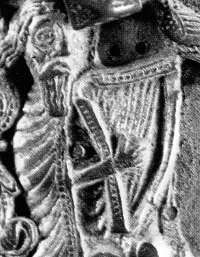
4. St. Mogue shrine harp,
late 10th or early 11th C.
Over the past thirty years many imitations of these early low-headed models have been built, but most differ significantly from the museum originals in ways that directly affect the stringing: fewer strings, altered string lengths, non-authentic strings or non-traditional tuning. On the other hand, those few copies that accurately follow the museum prototypes and are strung according to historical protocol display dramatically decreased string tensions as one descends through the lowest bass octave, leading to progressively poorer tone and making tuning increasingly elusive for the longest strings.6
Basic harp design principles provide the reason: the bass strings are not long enough to support the necessary pitches and maintain good tone and a consistent string tension when using known historical stringing and tuning methods (monofilament brass strings tuned diatonically with the exception of na comhluighe). It is illogical that Irish harpmakers and players would create and utilise thirty strings if the bottom ones were poor sounding, and the instrument's prestigious reputation implies that they were not. Assuming that the medieval clairseach did not suffer the poor bass sonority we witness today, could the tone change perhaps be traced to stringing practice?
There are four string variables to consider in harp design: pitch, length, diameter, and density/mass/specific weight. Relationships between them are explained with interrelated mathematical formulas that, without going into technical detail, reveal the following maxims:
If a string's tension is increased or decreased and string length, diameter and density remain the same, its pitch correspondingly rises or drops. This is our means of tuning the harp.
If a string's length is increased and all else remains the same, its pitch lowers (i.e. doubling the length drops the pitch an octave); conversely, if a strings length is decreased, its pitch raises (halving the length raises the pitch an octave).
If a string's diameter is increased, its pitch lowers (i.e. doubling the diameter drops the pitch an octave if everything else, including string tension, remains the same); if the diameter of a string is decreased, its pitch raises (reducing the diameter by half raises the pitch an octave if everything else remains constant).
If a string's density/mass/specific weight is increased and everything else remains the same, its pitch lowers (i.e. quadrupling the density lowers the pitch an ocatve); if only its density/mass/specific weight is lowered, its pitch raises (density reduction by 75% raises the pitch an octave).
The low-headed clairseach's bass tone problem is that the lengths for its required bass pitches are too short for brass strings, yet these lengths are set when the harp is made and brass is consistently named as the string material. One approach to combating this problem would be to increase tensions on the existing design by pitching the longest string where it sounds reasonable and ascending diatonically. Unfortunately, while there is considerable pitch latitude available for bass strings, this latitude shrinks as you ascend the gamut, and the top treble strings actually have very little room for adjustment. The longer strings can be raised several tones (of course reducing string diameters to keep similar tensions on the soundboard), but the shortest strings can be raised only a whole tone or so without breaking.7
Another theoretical approach would be simply to increase bass string diameters, raising tensions to a point where the bass strings will play, sound and tune well, but there are at least two flaws in practice. Not only does increasing string diameter create the possibility of soundboard tension overload, but it also increases string stiffness which, at larger gauges, begins to affect the string's vibration and thus playability, resonance and tonal harmonics. Doubling a string's diameter quadruples its tension and strength but increases its stiffness 16 times!
Stiffness at larger diameters may be minimised by twisting or weaving two or more thin strands together to create a single rope. However, evidence for twisted wire strings does not appear until the mid sixteenth century,8 which is too late for use on the low-headed clairseach. Wound or overspun strings are not seen until even later (seventeenth or eighteenth century).9 Furthermore, there is no documentation for the use of twisted or wound/overspun strings on either the low- or much later high-headed clairseach, and the author's personal experiments with twisted strings show but marginal improvement in tone and greatly increased fingernail wear.
Having failed to attain an effective low-headed bass through pitch or diameter alterations, the remaining option is to experiment with string material in order to increase the mass/density of the bass strings. A majority of contemporary makers choose the solution of wound strings or a modern phosphor bronze formulation that is audibly superior to brass when used in short basses. Like wound strings, however, phosphor bronze was not available to the low-headed tradition.10 Other makers have experimented with a different type of brass, such as the slightly denser red brass that contains a higher percentage of copper. Harpsichord makers favored this alloy, but their basses were extremely long. On short-bassed clairseachs the improvement is minimal, and the penalty is a lengthy brightening period before optimal tone is reached.
What other metals might have been used? For bass strings the metal would have to be denser than and at least as ductile as copper to be useful, and that narrows the field to only gold, silver and electrum (a silver-rich gold ore), all metals recorded in literature and tradition as music strings both within and outside of Gaelic areas.11 Unfortunately this evidence has been apparently dismissed as mythology, for until the late twentieth century there have been no known attempts to explore the parameters of such strings.12
Since at least the Bronze Age Ireland was known both for its large quantities of natural gold and for the skill of its smiths in working it, as evidenced in impressive museum collections. It is not known when the Irish first began to draw wire, but virtually all of their preserved literature and oral traditions specify metal as the material for their stringed crot & tiompán.13 The history of wire craftsmanship dates back at least to classical antiquity, but it is thought that the original methods of fabrication14 did not produce sufficiently uniform wire for musical use.15 Even if the old methods could not produce good music wire, the earliest dieplate currently known is one discovered in Viking Scandinavia that has been dated sometime between 500-700 A.D., so the knowledge and technology of wire drawing16 for Irish instruments was available most, if not all, of the Irish historical period and gold, being the most ductile metal,17 would undoubtedly have been the material of the first drawn wire.
The other precious metals mentioned, silver and findruine, would have served the same purpose as gold, only less effectively and at less expense. Therefore they are unlikely as substitutes for gold,18 but rather as complementary transitions between the gold and brass strings. At the other end of the harp we must consider the possibility of iron's use for the shortest strings because its increased tensile strength allows greater flexibility in establishing and pitching a gamut. An iron music string (téad diarann) is mentioned in the twelfth century tale Agallamh na Seanórach or Colloquy of the Ancients contained in the fifteenth century Book of Lismore, but Ephraim Segerman asserts that iron music wire was not available until the late fourteenth century.19 If Segerman is correct, the low-head clairseach tradition was by then too long established for the innovation to have made a significant impact. If iron strings were used regularly, it was likely when the clairseach began to show added strings in the later sixteenth century—a time when the use of water power to produce iron wire spurred an improvement in the quality of the coarse iron bar stock and thus in the final wire product.20
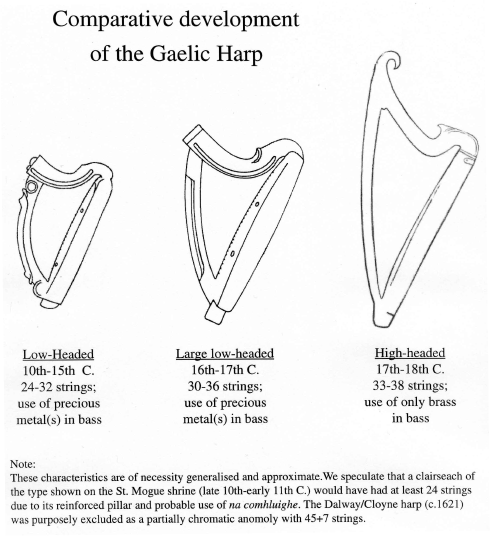
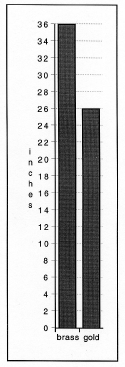
6. Density chart. Relative string lengths of brass and gold to produce a low C of 65 hz at approximately the same sound quality and soundboard tension.
Joan Rimmer has categorised the corpus of extant clairseachs into three distinct stages (see fig. 5): “[The clairseach's] development appears to have been in three stages, strikingly parallel to those of Irish political history. They cover roughly [small low-headed] the fourteenth to the mid-sixteenth century—the rich Norman-Irish period; [large low-headed] the mid-sixteenth to the late seventeenth century—the time of violence and English incursion under Elizabeth I and Cromwell; and [large high-headed] the late seventeenth to the mid-eighteenth century—the time of complete dissolution for the old Irish society and the establishment of Anglo-Irish society.”21
The history of precious metal strings can be viewed similarly. We posit that during the clairseach's golden age (!) gold strings were normally used for its lower range, and brass began where precious metal could no longer support increased tension. As the clairseach's noble patrons began to suffer under growing English control, harpers sought additional support from the newly-settled English landowners, and its popularity temporarily surged amongst English, Lowland Scottish and continental nobility. At this time the tradition experimented with an expanded gamut and chromaticism. When English control became complete and there was no longer support for the old Gaelic arts, patron-less harpers could no longer afford the luxury of a precious metal design, so a high-headed instrument that could be strung entirely in brass (save, perhaps, for a few iron strings in the treble) was created for them.
The facts that Ireland possessed:
• large quantities of natural gold ore;
• craftsmen skilled in working it;
• literature and traditions naming precious metal music strings; and
• an elite low-headed harp, where use of such strings in the bass solves an inherent sonority problem (see fig. 6)
all call for a serious exploration of gold and other historic precious metals as a material for music strings.
Appendix: Selected Excerpts of Irish Metal String References footnotes
Ann and Charlie Heymann 2003, 2004
The original article, of which this is a revised version, was edited by Cheryl Ann Fulton for the Historical Harp Society Journal, and is republished by permission.